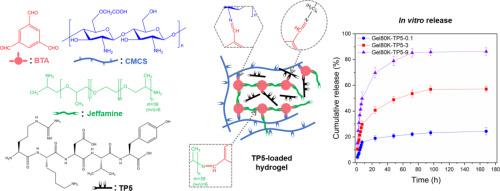Biomaterials Advances ( IF 5.5 ) Pub Date : 2021-05-27 , DOI: 10.1016/j.msec.2021.112210 Rui Yu 1 , Eddy Petit 1 , Mihail Barboiu 1 , Suming Li 1 , Wenjing Sun 2 , Congmei Chen 3

|
Thymopentin (TP5) is widely used in the treatment of autoimmune diseases, but the short in vivo half-life of TP5 strongly restricts its clinical applications. A series of blank and TP5 loaded hydrogels were synthesized via reversible dual imine bonding by mixing water soluble O-carboxymethyl chitosan (CMCS) with a dynamer (Dy) prepared from Jeffamine and benzene-1,3,5-tricarbaldehyde. TP5 release from hydrogels was studied at 37 °C under in vitro conditions. The molar mass of CMCS, drug loading conditions and drug content were varied to elucidate their effects on hydrogel properties and drug release behaviors. Density functional theory was applied to theoretically confirm the chemical connections between TP5 or CMCS with Dy. All hydrogels exhibited interpenetrating porous architecture with average pore size from 59 to 83 μm, and pH-sensitive swelling up to 10,000% at pH 8. TP5 encapsulation affected the rheological properties of hydrogels as TP5 was partially attached to the network via imine bonding. Higher TP5 loading led to higher release rates. Faster release was observed at pH 5.5 than at pH 7.4 due to lower stability of imine bonds in acidic media. Fitting of release data using Higuchi model showed that initial TP5 release was essentially diffusion controlled. All these findings proved that the dynamic hydrogels are promising carriers for controlled delivery of hydrophilic drugs, and shed new light on the design of drug release systems by both physical mixing and reversible covalent bonding.
中文翻译:

可逆亚胺键合生物基动态水凝胶控制胸腺五肽的释放
胸腺五肽(TP5)被广泛用于自身免疫性疾病的治疗,但TP5的体内半衰期短严重限制了其临床应用。通过混合水溶性O,通过可逆双亚胺键合合成了一系列空白和TP5负载水凝胶-羧甲基壳聚糖 (CMCS) 与由 Jeffamine 和苯-1,3,5-三甲醛制备的动力学 (Dy)。在体外条件下,在 37°C 下研究了水凝胶中 TP5 的释放。改变 CMCS 的摩尔质量、载药条件和药物含量以阐明它们对水凝胶特性和药物释放行为的影响。密度泛函理论被应用于理论上确认 TP5 或 CMCS 与 Dy 之间的化学联系。所有水凝胶均表现出互穿多孔结构,平均孔径为 59 至 83 μm,pH 敏感膨胀率在 pH 8 时高达 10,000%。TP5 封装影响水凝胶的流变特性,因为 TP5 通过亚胺键部分连接到网络上。更高的 TP5 负载导致更高的释放率。在 pH 5.5 下观察到比在 pH 7 下释放更快。4 由于亚胺键在酸性介质中的稳定性较低。使用 Higuchi 模型拟合释放数据表明初始 TP5 释放基本上是扩散控制的。所有这些发现证明,动态水凝胶是亲水性药物受控递送的有前途的载体,并通过物理混合和可逆共价键合为药物释放系统的设计提供了新的思路。











































 京公网安备 11010802027423号
京公网安备 11010802027423号